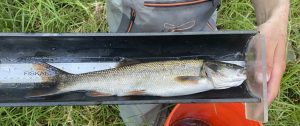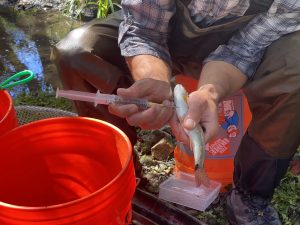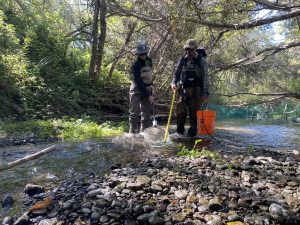Header photo courtesy of Stillwater Sciences.
The Morro Bay watershed is home to many sensitive aquatic species, including the Central Coast steelhead (Oncorhynchus mykiss). Steelhead are considered indicators of good water quality since they require cold, clean, well-oxygenated water to survive. They also transport important nutrients from the ocean back into freshwater streams when they return to spawn. Although once abundant in the watershed, steelhead are now listed as threatened under the Endangered Species Act. The Estuary Program prioritizes projects that benefit steelhead to help this fascinating species return to our watershed.
To learn more about steelhead, you can check out our 2023 State of the Bay Steelhead Indicator page.
Managing Predators: Pikeminnow Suppression
Chorro Creek is a key tributary to the Morro Bay estuary that provides high quality habitat for steelhead. Unfortunately a non-native fish called the Sacramento pikeminnow (Ptychocheilus grandis) poses a significant threat. These invasive fish not only compete with steelhead for food and habitat but also prey on young steelhead. The combination of predation and competition can reduce steelhead numbers, hampering their recovery in the watershed.
The Estuary Program has conducted pikeminnow suppression work in Chorro Creek since 2017 to address this issue. This management effort has led to a reduction in pikeminnow predation and helped us to better understand their impacts on steelhead populations.

The Estuary Program recently completed our fifth year of pikeminnow management. While analysis of the data is still underway for this year’s effort, we are excited to share the results with you soon!
Learning More About Our Steelhead
The Estuary Program is working on a new research project to study how steelhead use the creeks in the Morro Bay watershed. This effort utilizes Passive Integrated Transponder (PIT) tags which are inserted into the fish for the duration of its life. Very similar to microchips for cats and dogs, these small tags do not harm the fish.
Each tag contains a unique identification number that can be read with a device called a PIT tag antennae. If a tagged fish swims past an antennae, we can track its movements. This year, our team installed two PIT tag antennas along lower Chorro Creek. We can use this information to see when steelhead migrate into the estuary and how they utilize different habitats in the watershed. If we recapture a tagged fish, we can weigh and measure it to assess how fast it is growing.

Tagging steelhead is a delicate process. First, the team uses an anesthetic solution to calm the fish prior to handling. A trained biologist then uses a small needle to insert the PIT tag into the fish’s body. The biologist seals the incision and places the fish in a cool bucket of water. This bucket has oxygen pumped into it as well as a medicine that helps the fish recover faster. When the fish is fully recovered, it is released back into the creek.
How We Sample Fish
The Estuary Program samples fish in small streams using a method called electrofishing, which is a safe and efficient means to assess fish populations. Electrofishing involves the controlled release of electrical currents into the water. These currents temporarily stun the fish, making it easy for us to collect them. Upon capture, steelhead are weighed, measured, and tagged before being returned to the creek. Pikeminnow are measured before being humanely euthanized.

What’s Next?
The Estuary Program will continue the steelhead growth study and pikeminnow removal project, with sampling planned for spring and fall of 2024. Learning more about steelhead use of the watershed can help the Estuary Program protect and restore the habitats that are critical to the recovery of steelhead on the Central Coast.
Help us protect and restore the Morro Bay estuary!
- Donate to the Estuary Program today and support our work in the field, the lab, and beyond.
The Estuary Program is a 501(c)3 nonprofit. We depend on funding from grants and generous donors to continue our work. - Support us by purchasing estuary-themed gear from ESTERO. This locally owned and operated company donates 20% of proceeds from its Estuary clothing line and 100% of Estuary decal proceeds to the Estuary Program. Thank you, ESTERO!
- Purchase items from the Estuary Program’s store on Zazzle. Zazzle prints and ships your items, and the Estuary Program receives 10% of the proceeds. Choose from mugs, hats, t-shirts, and even fanny packs (they’re back!) with our fun Estuary Octopus design, our classic Estuary Program logo, or our Mutts for the Bay logo.
- We want to hear from you! Please take a few minutes to fill out this short survey about what type of events you’d like to see from the Estuary Program. We appreciate your input!